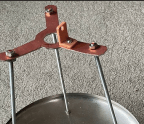
When we first get a new scanner, our enthusiasm dictates we throw in a bunch of frequencies right away so we can start playing with our new toy as soon as possible. When the initial excitement wears off, we realize a bit of organization is called for. Luckily, most scanners today have their memory channels organized in banks. For example, a 100-channel scanner may have 10 banks of 10 channels each. This makes organizing easier without us having to do much of anything beyond collecting similar frequencies (like local airports, places we travel to on vacation, and so on) together onto one list.


Although there are a lot of logging programs available on the internet, I’ve found it easier (and much less expensive) to create logs. In the example shown, the tab named “freq log” is a spreadsheet that I use as the “dumping ground” for all of the frequencies I have, or want to check. I garnered these frequencies from external references like the internet, notes from friends, band searches, etc. along with initial notes of the alleged service, notes of the actual service I’ve heard, location, and rating (discussed more in the next paragraph). I can then sort by whatever topic I choose: For example, if I know I’m going to a certain location on vacation, I can filter by that column and pre-program in a bank of frequencies to check out when I get there. Alternatively, I can sort by nearby locations & service type if I want to do some scanning from home (excerpt shown in ).






